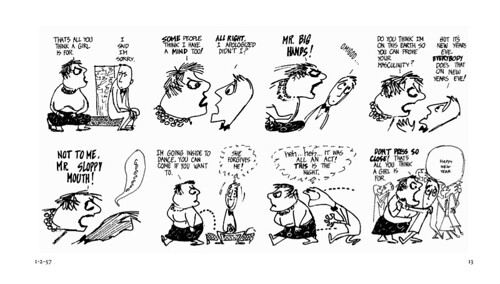When Norman Mailer, Dan Wolf and Ed Fancher established the Village Voice, they didn’t have experience in the newspaper business.
Fancher was the publisher of the Voice, Wolf the editor and Mailer was officially a silent partner. According to Menand, Wolf later said “If we had known more, we certainly would have suffered less.” Nonetheless, the Village Voice thrived and, in the process, set a standard for newspapers in the nineteen-sixties.
The Village Voice was influential, from its layout to its content.
Menand described the first issue as having “an attractive white-on-black, black-on-white logo designed by a student of Hans Hofmann, Nell Blaine, who was an important figure in the postwar art world.”
Aside from the logo, the paper’s layout was cut-and-paste. Menand said “the eccentricity of the jumps in the Voice — page 1 to page 12, say, finishing with half an inch on page 3 — became notorious.”
And despite the Voice being primarily comprised of advertisements (which acquired approximately two-thirds of the paper), it was never deemed a “shopper” — a free publication that people pick up for the ads rather than reading material. This may have been a result of it’s originality.
The Village Voice published local stories about panels or classes at the New School. It included full coverage of the arts and there were columns on shopping and fashion. It also included reviews; Michael Harrington wrote one in the first issue and he became a regular contributor, along with his wife, Stephanie Gervis. “Beginning with the third issues, there was a letters section, whose tone of amused outrage did a lot to define the character of the paper and its readership,” according to Menand. There were many regular columnists in the Voice’s early history.
Mailer began writing his own column, “QUICKLY: A Column for Slow Readers,” in 1956. The column was not well-received by readers, and it provoked letters asking the Voice to lose him. Menand quotes Mailer, who wrote: “The only way I see myself becoming one of the cherished traditions of the Village is to be actively disliked each week.” He managed only seventeen columns, and even his editor, Jerry Tallmer, hated the columns.
Also in 1956, the Village Voice began running a weekly comic strip by Jules Feiffer. His strips were about the lack of fit between people and words. They always consisted of people attempting to talk their way through or around something but failing to effectively do so. Feiffer was loved on Madison Avenue, despite his frequent depictions of madmen. His comedic approach made fun of the establishment without being anti-establishment. Feiffer’s strips ran for 41 years.

Image retrieved from: fantagraphics
To read more about the background of the Village Voice, click here.

Leave a response